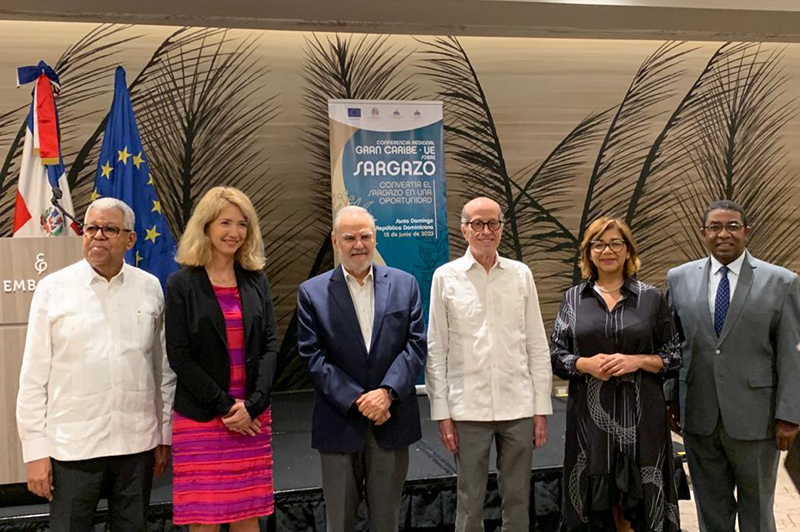The Ministry of Foreign Affairs and the Ministry of Environment and Natural Resources of the Dominican Republic jointly organized with the European Union (EU)
a conference to exchange information on how to mitigate or use sargassum for the benefit of the entire Caribbean region. The conference took place June 15, 23023 in Santo Domingo.
The Greater Caribbean – EU Regional Conference: Turning Sargassum into Opportunity brought together authorities from the public sector, national and international experts, representatives of the private sector and the scientific and academic community of the region. During the conference, the impact and risks of sargassum, its monitoring and management, its recovery and possible uses were discussed, with a view to promote public policies, regional frameworks and reinforcing cooperation to promote investment from the private sector.
“The Caribbean coasts from the east of the island of Tobago to the west of Tulum in Mexico receive millions of tons of sargassum. Sargassum is a seaweed that naturally floats on the surface of the ocean. In adequate amounts, it helps balance marine ecosystems, but its massive proliferation, which occurs only on the Caribbean coasts, generates considerable losses for local communities and the tourism sector. It also causes serious, perhaps irreparable damage to marine ecosystems, human health, and puts the energy security of the Caribbean countries at risk.” These were the words of Roberto Álvarez, Foreign Minister of the Dominican Republic, to announce the conference.
“We have to make sure we find common solutions and the EU will lead this effort,” said Frans Timmermans, Executive Vice President of the European Commission and for the European Green Deal.
For his part, the Minister of the Environment of the Dominican Republic, Miguel Ceara Hatton, indicated that policies must be designed within the framework of great uncertainty.
The Ambassador of the European Union in the Dominican Republic, Katja Afheldt, pointed out that the EU and its Member States are committed to supporting partner countries and that this is a commitment at the highest level.
The director for Latin America and the Caribbean and all overseas countries and territories at the European Commission in the Directorate General for International Partnerships, Félix Fernández-Shaw, believes that a structured, political and practical approach is needed such as that provided by the EU's Global Gateway Investment Agenda.
“We are facing an extremely complex problem, it requires an extraordinary collective effort that concentrates all our knowledge and resources in the search for practical and lasting solutions to a responsibility of our generation to turn sargassum into an opportunity,” said Dominican Foreign Minister Roberto Álvarez.
At the end of the conference, the EU Ambassador stated that sargassum could be part of the energy transition as a base material for biofuels, sustainable construction materials and renewable material in the textile industry. At the same time jobs could be created in the collection at sea, application and repair of types of collection and transport and in the transformation and creation of new industries.
For the Ambassador, there are still challenges such as the need for funds to finance research and encourage the private sector to intervene in the sargassum industry. Finally, she added that the most important challenge is time, or rather the lack of time because sargassum is already growing in quantities every year and that impacts ecosystems, the tourism sector and human health. That is why action focused on all the actors who can contribute is so important.
